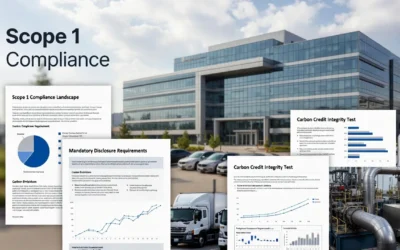As global corporate entities strive to align their operational ethos with the urgent demands of climate change mitigation, the task of realigning business practices to meet stringent environmental targets has never been more critical. The Science Based Targets initiative (SBTi) plays a pivotal role in guiding these efforts. However, recent shifts in their standards underscore the complexities and challenges that corporations face in reaching their climate commitments. Amidst these challenges, Dynamic Carbon Credits offers an innovative plant-based solution that promises not only to cost-effectively help companies meet these new requirements but also to accelerate substantial environmental benefits.
Understanding the SBTi Updates
SBTi has been instrumental in pushing companies towards scientifically aligned climate goals. Their standards ensure that corporate emission reduction strategies are in line with what the latest climate science deems necessary to meet the goals of the Paris Agreement — notably to limit global warming to 1.5°C above pre-industrial levels.
Recently, SBTi announced a forthcoming update to its guidelines, particularly concerning Scope 3 emissions — the indirect emissions that occur in a company’s value chain, which are notoriously difficult to measure and mitigate. These updates are significant because they signal a potential allowance for Environmental Attribute Certificates (EACs), including certain types of carbon credits, to count towards Scope 3 emission reduction targets. This marks a pivotal shift from SBTi’s earlier stance, which primarily emphasized direct action over carbon credit offsets.
Corporate Climate Commitments Challenges
The challenge for corporations to meet Scope 3 emissions is immense. Scope 3 emissions can constitute the majority of a company’s carbon footprint, encompassing everything from the extraction of raw materials to the end-of-life treatment of sold products. Reducing these emissions requires a herculean effort in transparency, supplier engagement, and innovative mitigation strategies. The gap highlighted by MSCI Carbon Markets—indicating companies are falling 1.4 gigatons of CO2 short of their targets annually—points to the scale of the challenge ahead.
Dynamic’s Plant-Based Carbon Credits: A Strategic Bargain
In this complex landscape, Dynamic Carbon Credits offers a compelling solution through plant-based carbon credits, specifically those derived from biochar. Biochar, a stable form of carbon created from plant materials, sequesters carbon when added to soil, enhancing soil health and increasing agricultural productivity while locking carbon away from the atmosphere.
Cost-Effectiveness and Rapid Implementation: Unlike more complex sequestration technologies or comprehensive supply chain overhauls, implementing biochar projects is less capital intensive and can be rapidly scaled. These projects provide a shovel-ready solution for corporations looking to quickly adjust their carbon accounting under new SBTi guidelines.
Alignment with EACs Standards: As SBTi evolves to potentially include EACs in Scope 3 calculations, Dynamic’s biochar credits are poised to be an optimal choice. These credits are verifiable, scientifically validated, and contribute directly to the reduction of atmospheric CO2 levels, thus aligning with both current and emerging regulatory frameworks.
Dual Benefits: Beyond carbon sequestration, biochar projects contribute to a broader range of environmental and social objectives, including waste reduction, improved water quality, and enhanced agricultural resilience. This multiplicity of benefits can help corporations meet various corporate social responsibility (CSR) objectives simultaneously.
Conclusion
As the details of the SBTi’s updated guidelines unfold, corporations have a unique opportunity to reconsider their strategies for meeting net-zero targets. Dynamic Carbon Credits provides an accessible, effective, and immediate solution to the pressing challenge of Scope 3 emissions. Investing in plant-based credits like biochar not only aligns with emerging standards but also propels corporations towards a leadership role in the urgent global transition to sustainability.
By leveraging Dynamic’s innovative solutions, companies can transform their environmental impact and emerge as front-runners in the race against climate change, turning compliance into opportunity and cost burdens into investment in a sustainable future. As the corporate world pivots to meet these new challenges, the simplicity, efficacy, and scalability of biochar carbon credits offer a clear path forward.





